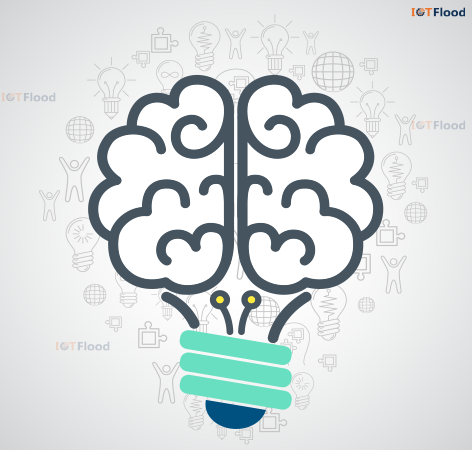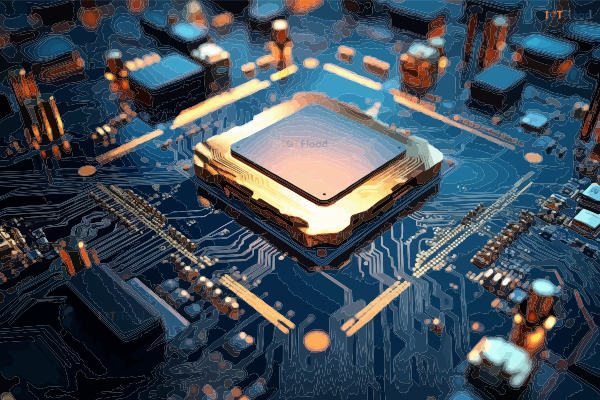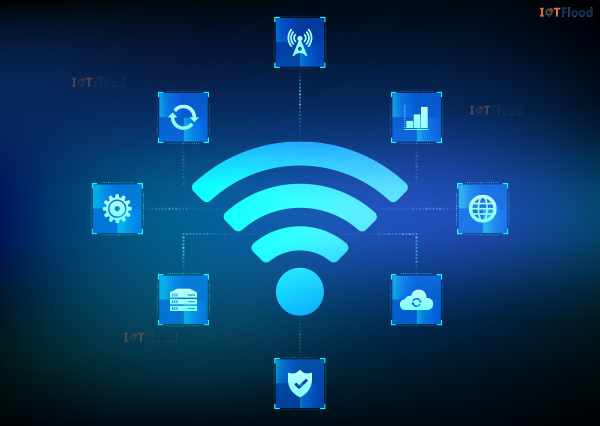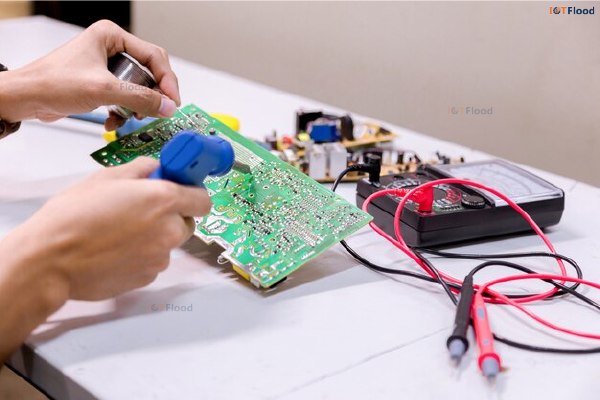Building Your Own First IoT Project
By building a network of intelligent systems and interconnected devices, the Internet of Things (Iot) is a rapidly expanding field that has the potential to transform industries and enhance everyday life. Due to this interconnection, data interchange, automation, and communication are all possible, resulting in greater productivity, efficiency, and creativity across various industries. Building your first Internet of Things (Iot) project, however, requires more than just enthusiasm; it also necessitates careful preparation, a solid technological foundation, and meticulous attention to detail.
Starting an Iot project can be both exciting and gratifying, allowing you to address real-world problems, optimise operations, and develop creative solutions. However, it also brings with it difficulties, such as selecting the appropriate hardware and software components, designing a scalable architecture, ensuring data security and privacy, and resolving compatibility issues. You can fully utilise Iot technology and help further the revolution of daily life and industry by starting your first Iot project with meticulous preparation, continuous learning, and attention to detail.
What is Embedded Programming?
The process of creating software especially meant to run on embedded systems is known as embedded programming. A microcontroller in a car’s engine control unit, a thermostat in a smart home system, or a sensor in an industrial machine are examples of embedded systems—specialised computer systems embedded in larger devices or systems.
Writing code that directly communicates with the embedded system’s hardware, including its sensors, actuators, and memory, to perform specific tasks is known as embedded programming. Programming languages like C, C++, and occasionally assembly language are required for embedded systems development, and a thorough understanding of hardware design is also necessary.
Among the essential components of embedded programming are:
- Real-time Constraints: Many embedded systems operate in environments where they must complete tasks within a specified time frame. Within these temporal constraints, embedded programmers must write code that can react to events and handle data effectively.
- Resource Constraints: Memory, CPU power, and energy are only a few examples of the scarce resources that embedded systems frequently face. To ensure dependable performance within these limitations, programmers must optimise their code.
- Hardware Interaction: By developing code to receive sensor data, control actuators, maintain communication interfaces (such as UART, SPI, and I2C), and handle interrupts, embedded programmers collaborate directly with hardware components.
- Low-level Programming: Bit manipulation, direct memory access, and hardware-specific optimisations are examples of low-level programming that can be a part of embedded programming.
- Testing and Debugging: Since embedded software has limited insight into the underlying system’s workings, testing and debugging it can be challenging. To test and debug their code, embedded programmers employ tools such as hardware debuggers, emulators, and simulators.
Embedded programming is crucial to the development of embedded systems across various sectors, including consumer electronics, automotive, healthcare, industrial automation, and others.
Embedded Programming
The software foundation that enables Internet of Things (Iot) devices to connect, interact, and perform tasks in various contexts is provided by embedded programming, which forms the core of these devices. The capability of embedded programming in the Internet of Things to directly interface with hardware, including sensors, actuators, and communication modules, is a crucial feature. With the help of this low-level control, developers may create real-time processing capabilities—which are crucial for many Internet of Things applications—and optimize performance and resource management.
Embedded programming in the Internet of Things involves developing networking and communication protocols, as well as interacting with hardware. This consists of controlling the flow of data over wired and wireless networks, ensuring secure connections, and integrating cloud services for analytics, remote management, and data storage.
To safeguard sensitive data and prevent unauthorised access, embedded programmers play a crucial role in integrating robust security features, such as access control, authentication, and encryption, into the software. Security is a top priority in the Internet of Things.
In the Internet of Things, firmware development and maintenance are integral to embedded programming. For Iot devices to get new features, boost performance, or fix security flaws, firmware updates are frequently necessary. To ensure the long-term reliability and performance of Iot devices across various applications and use cases, embedded programmers develop firmware that can be updated quickly and securely.
What is an Iot project?
Once upon a time, in a bustling city, a group of entrepreneurs commenced an Iot project that would completely transform the way urban waste was managed. Their concept was to design intelligent trash cans with sensors that could track the fill level of the bins in real-time. Waste collection crews would then be able to optimise their routes based on which bins needed to be emptied the most urgently once this data was transferred to a central system via the internet. This was expected to lower operating expenses while also making the city cleaner and more effective.
In this hypothetical scenario, the Internet of Things project involved creating and placing sensor-equipped trash cans in strategic metropolitan locations, such as parks, business districts, and major intersections. Every bin features a cellular or Wi-Fi module to transmit data to the cloud, as well as ultrasonic sensors to measure the fill level. The data was analysed, collection schedules were prioritised, and the routes of waste collection trucks were optimised by the central waste management system using sophisticated algorithms. Thanks to the creative Iot initiative, the city observed a considerable decrease in fuel consumption, less traffic congestion as a result of more effective routes, and an increase in general cleanliness.
Why do you need to build your Iot project?
Developing an Iot project has several advantages that promote creativity, productivity, and better decision-making in a range of fields. First and foremost, Iot initiatives make it possible to gather enormous volumes of data from systems, sensors, and linked devices. This data offers insightful information about customer behavior, operations, the environment, and other topics. Organisations can identify opportunities for improvement, streamline operations, and make data-driven decisions by leveraging the Internet of Things.
Second, IoT initiatives improve system and device connectivity and communication. Due to this connectedness, processes can be monitored, controlled, and automated in real-time, which enhances productivity and reduces downtime. Iot-enabled predictive maintenance, for instance, can identify equipment problems in industrial settings before they happen, reducing downtime and maintenance expenses.
Thirdly, IoT initiatives stimulate creativity and make it possible to create brand-new goods, services, and business models. Businesses may set themselves apart from the competition, provide customers with individualised experiences, and generate new revenue streams by incorporating Iot capabilities into their products and services. IoT also makes it easier for departments and stakeholders to collaborate and integrate, which promotes an innovative and continuous improvement culture inside businesses.
How to Deploy an IoT Project Successfully?
Comprehending the day-to-day obstacles that customers and the business confront is crucial for the successful implementation of an IoT project. This entails conducting an in-depth study, gathering input, and identifying sectors in which Iot solutions can have a significant impact. The next stage after identifying these pain areas is to create a workable implementation plan. This involves defining data management and analytics procedures, creating an effective network architecture, and choosing the appropriate hardware and software components.
Establishing reasonable expectations and goals is another essential component of a successful IoT deployment. It is vital to develop quantifiable key performance indicators (KPIS) and clear objectives to monitor the project’s progress and effectiveness. A successful implementation is ensured by streamlining the deployment process through careful planning, testing, and stakeholder collaboration. By using these strategies and focusing on solving practical issues, companies can fully utilise Iot technology and achieve significant results.
From ideation to implementation, this article will serve as your road map for developing your first Internet of Things project. We’ll work through each stage, from generating ideas for solving problems to testing and refining the finished product. You will learn how to create an efficient Iot architecture, identify the best hardware and software components, develop and prototype your solution, and start by establishing your project objectives and doing market research. You can ensure your Iot project is secure, operational, and prepared to have an impact on the connected world by using testing, validation, and deployment techniques.
Getting Started with Your IoT Project
Define your Project: Identify a Need
Defining your project begins with recognising a requirement that IoT can meet. Since it lays the groundwork for the entire development process, this step is essential. Look for places where IoT can be of assistance at your house, place of employment, or hobbies. Could you automate a repetitive job to save time and effort? Are there any safety issues where real-time alarms and monitoring would be beneficial? Perhaps you’re passionate about gardening and want to develop an intelligent system that can monitor the health of your plants and automate watering. Alternatively, you may want to enhance the ambience of your living area by installing a lighting system that allows you to adjust its brightness.
Establishing a targeted issue or domain where IoT technology can have a significant influence establishes the foundation for a well-defined and efficient endeavor. The potential benefits for end users or stakeholders, such as increased productivity, enhanced security, improved convenience, or more effective resource management, are also considered during this process. After a requirement has been identified, you can proceed to ideation and conceptualisation to create an effective Iot solution.
Conduct Market Research
Analysing the target sector or application area in-depth is necessary when conducting market research for Iot solutions. First and foremost, it’s critical to determine whether IoT solutions are currently in use by rival companies or market leaders. This entails being aware of their features, capabilities, cost structures, and market positioning. You can learn about market gaps, competitive advantages, and places where your project might stand out from the competition by researching your competitors.
In addition, how IoT solutions are shaped is greatly influenced by market developments. This encompasses developments in edge computing, the advancement of connection standards like 5G, and trends in technology utilisation, including the integration of AI and machine learning. Furthermore, user preferences and demands come first. Customising Iot solutions that appeal to target audiences requires an understanding of user expectations, pain spots, and desired outcomes. To guarantee that the IoT project complies with industry norms and legal frameworks, particularly with regard to data security and privacy, regulatory requirements and compliance standards must also be taken into account.
Design your IoT Architecture
To safeguard data integrity and prevent unauthorised access, the Internet of Things architecture should incorporate security features, including encryption, secure communication protocols (such as TLS/SSL), authentication, and authorisation. For efficient management of user roles and permissions, consider identity and access management (IAM) solutions. Utilise tokens or digital certificates for device authentication to ensure that only authorised devices can connect to the system. Maintaining a safe IoT environment requires regular security audits, vulnerability assessments, and incident response strategies.
For smooth integration and data sharing, systems must be able to communicate with one another. To ensure interoperability with legacy systems, third-party services, and other IoT platforms, use standard protocols such as OPC UA, AMQP, or RESTful APIs. Utilise data transformation and normalisation techniques to ensure that the various protocols and data formats used by the ecosystem’s systems are consistent and compatible with one another. Collaborate with industry standards organisations and participate in interoperability testing to verify conformity to industry standards and ensure compatibility.
Learn the Basics: Build Your Foundation
The key components of IoT are critical in enabling seamless communication, data exchange, and intelligent decision-making.
Actuators and sensors are the eyes and ears of Internet of Things (Iot) systems, gathering information about motion, temperature, humidity, and other environmental factors. Conversely, actuators allow devices to perform actions (such as turning on a light or regulating a thermostat) based on that data. These elements are necessary to collect data in real-time and initiate automated responses.
Connectivity: To send data to centralised systems or other devices, Internet of Things (Iot) devices rely on a variety of communication protocols, such as Wi-Fi, Bluetooth, Zigbee, LoRaWAN, or cellular networks. Range, bandwidth, power consumption, and data transfer speed are some of the key parameters that determine which networking protocol is best suited for enabling dependable and effective communication within Internet of Things (Iot) ecosystems.
Cloud computing: Because cloud platforms offer scalable storage, processing power, and analytics capabilities for the massive volumes of data created by IoT devices, they play a critical role in the Internet of Things. With the help of cloud services, businesses can safely store and handle data, conduct real-time analytics, and get valuable insights that help them make wise decisions and optimize their Internet of Things systems.
Data analytics and machine learning: To glean insightful information from unprocessed data, Internet of Things initiatives often utilise data analytics and machine learning algorithms. Descriptive, predictive, and prescriptive analytics are a few examples of data analytics techniques that aid in identifying trends, projecting results, and streamlining operations. IoT systems may learn from data, anticipate future events, automate tasks, and develop over time thanks to machine learning algorithms, which let them make decisions that are increasingly intelligent and self-sufficient.
Choosing the Right Hardware: Building Block Selection
Your IoT project’s success depends on your selection of hardware components. Here is a thorough explanation of the essential elements you should think about:
SBC (Single Board Computer)/microcontroller:
- Your IoT device’s microcontroller, also known as an SBC, is its brain, handling calculations, data processing, and device control. ESP32, Arduino boards, Raspberry Pis, and other microcontrollers with integrated Bluetooth or Wi-Fi are popular choices.
- Think about things like memory, I/O pins, computing power, and compatibility with development environments and programming languages.
Sensors:
Select your sensors based on the precise data your project requires. Typical sensor choices are as follows:
- Temperature sensors: to monitor temperature changes.
- Light sensors: used to measure ambient brightness or light levels.
- Motion sensors: to identify presence or movement.
- Humidity sensors: used to gauge ambient humidity levels.
Select sensors that meet the requirements of your application in terms of accuracy, range, and sensitivity.
Actuators (where appropriate):
Actuators are essential for projects that involve controlling physical elements, as they enable actions to be taken in response to data inputs. Examples include:
- LEDs: for visual indications and status messages.
- Relays are used for the remote control of switches or appliances that operate on electricity.
- Servo motors: for exact positioning or movement control of machines.
Select actuators that are compatible with your microcontroller or System-on-Chip (Soc), control mechanisms, and power requirements.
Connectivity Module:
Based on the connection protocols needed for your Internet of Things system, select a connectivity module. Choices consist of:
- Wi-Fi modules: for wireless access to the internet or a local network.
- Bluetooth modules: for wireless communication between devices at short distances
- Cellular modems: to connect to cellular networks, making them useful for remote or mobile IoT applications.
Consider factors such as power consumption, range, data transfer speeds, and compatibility with your microcontroller or System-on-Chip (Soc).
Power Supply:
Choose your IoT device’s power source by taking into account elements like mobility, energy efficiency, and component power requirements.
- Batteries: Depending on the device’s longevity and power requirements, select either disposable or rechargeable batteries for portable or remote Internet of Things (Iot) devices.
- USB connection: Consider using USB power banks or adapters for devices that are connected to a computer or other USB power source.
- AC adapter: Use AC adapters with the correct voltage and current ratings for devices that require constant power.
You can create a dependable Iot device that fulfils your project goals and performs well by carefully choosing and combining these hardware parts.
Select your Platform
Choosing the appropriate platform is a crucial choice for IoT development. Beginners frequently choose cloud systems like Microsoft Azure IoT and Amazon Web Services (AWS) IoT for controlling devices, storing data, and developing user interfaces. These platforms make development more efficient and accessible for beginners by offering pre-built functionalities, robust security measures, and scalability options.
Along with interfaces with other AWS services like Lambda functions and S3 storage, AWS IoT provides a full range of services for device management, data processing, and analytics. Similar to this, Microsoft Azure IoT offers a variety of tools and services for data storage, real-time analytics, and device connectivity. These are seamlessly integrated with other Azure services, like Azure Functions and Cosmos DB.
Although platforms make development easier and offer ready-to-use solutions, it is essential to consider your project’s specific needs and objectives before making a decision. In some instances, platforms may not be required; instead, custom solutions or on-premises installations may be necessary. Scalability, security, pricing, and integration capabilities are key considerations when selecting a platform or evaluating alternatives, such as self-hosted or open-source platforms.
Develop your Code: Bringing it to Life.
Writing the code is a crucial first step in making your IoT project a reality after you have put your hardware together. You will likely use Arduino C++ or a similar embedded language for microcontroller-based projects, such as Arduino. Even novices can easily learn to code thanks to Arduino’s integrated programming environment (IDE), which provides an intuitive platform with libraries and examples to simplify the process. Extensive assistance and resources for learning and troubleshooting are available through online forums, documentation, and tutorial websites, including the official Arduino website and community forums.
On the other hand, Python is a well-liked option for working with single-board computers (SBCS) like the Raspberry Pi, due to its readability, adaptability, and extensive libraries for Internet of Things (Iot) applications. The official Raspberry Pi website offers a wealth of projects, tutorials, and forums where you can explore project ideas, find code snippets, and access community support. Python is an excellent choice for activities such as data processing, device control, and interacting with sensors and actuators due to its robust capabilities and ease of use.
Each cloud-based Iot platform, such as AWS Iot, Azure Iot, or Google Cloud Iot, offers resources, SDKS, and development tools unique to that platform. These platforms frequently offer a variety of programming languages, such as Python, Java, C#, and Node.js, allowing developers to select the one that best suits their skills and the project’s needs. Your Iot system can be made more capable by utilising cloud services, which can include scalability, data management, remote device management, and integration with analytics and machine learning services.
Built the Circuit: Connecting the Pieces
Connecting the various components by the schematic or circuit diagram supplied by the manufacturer or online tutorials is the process of building the circuit. Breadboards are a good starting point for beginners because they simplify prototyping and eliminate the need for soldering. Breadboards are ideal for experimenting with various setups and functionalities, as they enable quick adjustments and testing of circuit layouts.
Soldering the connections will result in a more durable solution once you have tried and refined the circuit design on a breadboard. By ensuring strong and dependable connections between parts, soldering lowers the possibility of loose connections or short circuits. To create a polished and long-lasting circuit layout, adhere to best practices for soldering, which include utilising the proper soldering equipment, procedures, and safety precautions.
Test and Validation
To make sure your IoT project is reliable and functional, testing is a crucial step. Start by executing your code on the SBC or microcontroller, monitoring sensor data, and ensuring the actuators behave as expected. To identify and resolve any logical issues or programming errors, utilise the debugging tools provided with the development environment or other third-party tools.
Be ready for any unexpected behavior or difficulties during the testing process. Testing hardware connections, examining code for errors or inefficiencies, and resolving component communication problems are some examples of troubleshooting. Technical documentation, community platforms, and online forums are excellent tools for debugging common issues with specific components, programming languages, and Internet of Things (Iot) platforms. Ask questions, interact with the community, and use the pooled knowledge to improve your IoT project and solve problems as they come up.
1. Functional testing: Ensure all components of your Internet of Things system are functioning correctly by conducting thorough tests. Verify system dependability, device responsiveness, and data accuracy across various scenarios.
2. Security Testing: Use security measures to guard against cyber threats and unauthorized access to IoT devices and data, such as secure communication protocols, data encryption, and authentication methods. To identify and address security flaws, conduct penetration tests and vulnerability assessments.
3. User Acceptance Testing (UAT): Engage stakeholders or end users in evaluating your IoT solution to get their opinions on functionality, performance, and usability. Take customer feedback into account to make the required adjustments.
Deployment and Maintenance
When your IoT project has completed testing and validation, it’s time to deploy it in a production environment and make sure it receives continuous support and maintenance.
1. Deployment strategy: When planning your deployment strategy, consider variables such as network infrastructure, geographic locations, scalability, and regulatory compliance. Evaluate system performance in real-world circumstances and minimise risks by conducting trial deployments or phased rollouts.
2. Monitor and Optimise Performance: Utilise analytics dashboards and monitoring tools to keep tabs on data trends, system health, and Iot device performance. To improve functionality, efficiency, and user experience, continuously optimise your Iot solution based on user feedback, data insights, and emerging technologies.
3. Maintenance and Upgrades: To guarantee the long-term dependability and security of your IoT system, create a maintenance programme that includes frequent hardware maintenance, software upgrades, and security patches. To proactively address any issues, stay current with industry standards, technological advancements, and evolving cybersecurity threats.
How Much Does It Cost to Build an IoT Project?
The cost of developing an Internet of Things (Iot) project can vary significantly based on a variety of factors, including the project’s complexity, the quantity of devices involved, the degree of customisation needed, and the selected technological stack. When developing an IoT project, keep the following essential costs in mind:
Hardware costs: These comprise the price of connectivity modules (Wi-Fi, cellular, LoRa, etc.), IoT devices (sensors, actuators, modules), and any required gateway or edge computing gear. Hardware can vary significantly in price depending on several criteria, including brand, quantity purchased, and utility.
Software Development Costs: The creation of firmware for Internet of Things devices, backend infrastructure (servers, databases, APIS), cloud services (storage, data processing), and application development (web or mobile apps for user interface and data visualisation) are all included in the costs of software development.
Connectivity Costs: The expenses related to data communication and connectivity services may vary depending on the project’s specifications. This covers subscription fees for cloud services, data plans for cellular access, and any payments for data transmission and API usage.
Security Costs: To safeguard data, devices, and networks from cyberattacks, IoT projects frequently need strong security measures. Expenses for security audits, encryption, authentication systems, and security procedures should be factored into the budget.
Integration and Testing Costs: Important phases in the development of an IoT project include integrating IoT components and verifying their functionality, performance, and scalability. Expenses for quality control, debugging, testing tools, and integration should all be included in the budget.
Maintenance and Support Costs: After launching an Iot project, continual maintenance, software upgrades, technical support, and monitoring services are required to ensure peak performance and dependability. Setting up money for ongoing upkeep and assistance is essential.
Given that Internet of Things (Iot) projects can range from straightforward prototypes to intricate, enterprise-level installations, it is challenging to provide a precise cost estimate without understanding the project’s specifics. To ascertain the budget needed for your particular IoT project, you must first carry out extensive planning, research, and cost analysis. Effective cost management can also be achieved by utilising open-source tools and platforms, consulting with Iot specialists, and considering scalability and future growth.
IoT Applications
Utilizing networked devices to collect data, automate procedures, and enhance decision-making, Internet of Things (IoT) applications cover a broad spectrum of sectors and use cases. Here are a few noteworthy IoT applications from a range of industries:
Smart Home Automation: The Internet of Things (IoT) makes it possible to remotely control and automate household appliances, lighting controls, security cameras, and thermostats. For homeowners, this technology improves security, convenience, and energy efficiency.
Industrial Iot (IIoT): Iot devices are utilised in manufacturing and industrial environments for inventory management, real-time equipment monitoring, predictive maintenance, and production process optimisation. The Industrial Internet of Things (IIoT) boosts safety, reduces downtime, and enhances operational efficiency.
Healthcare Monitoring: Wearable sensors and medical equipment are examples of Internet of Things (IoT) devices that may track medication adherence, monitor patient health parameters, and provide remote patient monitoring.
Smart Cities: The Internet of Things is utilised in innovative city programmes to manage waste, traffic, energy consumption, and public safety. Residents’ quality of life is improved, services are optimised, and city infrastructure is optimised through the use of sensors, cameras, and data analytics systems.
Agricultural IoT (AgriTech): IoT applications in agriculture include soil and crop health monitoring, precision irrigation systems, and livestock tracking. These innovations enhance sustainable farming methods, improve resource utilisation, and increase agricultural productivity.
Retail and Supply Chain: Inventory tracking, supply chain visibility, and logistics optimisation are achieved in retail and supply chain management through the use of IoT devices like RFID tags, beacons, and inventory management systems. IoT increases customer satisfaction, decreases stockouts, and increases inventory accuracy.
Energy Management: Through energy consumption monitoring, HVAC system optimisation, intelligent grid management, and integration of renewable energy sources, IoT plays a critical role in energy management. This technology enables sustainable development, lowers energy costs, and promotes resource efficiency.
Transportation & Logistics: Fleet management, predictive maintenance for cars, route optimisation, and vehicle tracking are some of the IoT applications in transportation. These solutions increase total logistical operations, decrease fuel consumption, and improve transportation efficiency.
These illustrations show the broad spectrum of Internet of Things applications that, by utilising linked devices, data analytics, and automation capabilities, are revolutionising industries and spurring creativity.
IoT Companies
In the IoT (Internet of Things) arena, a number of well-known businesses drive innovation, create platforms, and provide solutions for a range of industries. Here are a few well-known IoT businesses:
Amazon Web Services (AWS): AWS provides Internet of Things (IoT) services that facilitate scalable data processing, secure device communication, and management. A wide range of industries, including smart homes, manufacturing, healthcare, and agriculture, are supported by its IoT platform.
Microsoft Azure IoT: This platform offers all-inclusive solutions for data analytics, IoT device management, and AI and machine learning integration. Azure Iot is extensively utilised in industries including logistics, retail, and smart cities.
Google Cloud IoT: This cloud platform provides real-time analytics, data ingestion, and device provisioning services. Their platform is well-suited for Internet of Things applications in predictive maintenance, energy management, and other areas, as it integrates with Google Cloud’s AI and data analytics technologies.
IBM Watson IoT: This platform from IBM offers AI-powered insights, device management, and data analytics. It is utilised for asset tracking, predictive maintenance, and operational optimisation in sectors including manufacturing, healthcare, and utilities.
Siemens: Siemens provides Internet of Things (IoT) solutions for energy management, innovative infrastructure, and industrial automation. For industrial applications, its Internet of Things platform, MindSphere, facilitates digital twin simulations, data analysis, and connection.
Cisco IoT: Cisco offers networking, security, and data management IoT solutions. Their IoT platform allows for safe and scalable IoT deployments across sectors by integrating with Cisco’s networking infrastructure.
Intel IoT: For IoT developers and businesses, Intel provides hardware solutions, software tools, and development kits. Their IoT systems concentrate on connection for IoT devices, edge computing, and AI integration.
Huawei IoT: Huawei offers Internet of Things solutions for energy, transportation, healthcare, and smart cities. For IoT installations, its platform, OceanConnect, provides connectivity, data management, and application development capabilities.
By allowing connectivity, data analytics, and automation for a wide range of IoT applications and use cases, these companies significantly contribute to the innovation of the Internet of Things.
The Challenges of IoT Project
The adoption of Iot technologies allows organisations in various industries to optimise operations, create new revenue streams, and improve consumer relations. A Gartner study reveals that 60% of Iot adopters expect significant changes inside their organisations, including considerable revenue growth and cost reductions, over the next five years. Furthermore, within three years, forty per cent of these adopters anticipate observable benefits. Nevertheless, enterprises that hastily implement Iot without conducting comprehensive research and development frequently fail to realise its full promise.
Starting with the concept of a connected product without first determining its value proposition is a common mistake. This strategy frequently results in failed IoT projects since the business does not fully comprehend the fundamental issue that these projects are meant to address. To secure successful outcomes and optimal returns on investment, organisations must take the time to understand the difficulties they face before using Iot.
Conclusion
Successful IoT projects necessitate detailed analysis, strategic planning, and a thorough grasp of how technology can provide value for enterprises. Implementing Iot quickly without conducting an adequate study and developing a clear plan would likely result in significant problems and less-than-ideal results. Businesses must devote time and resources to comprehending the nuances of IoT technologies, assessing how they could affect operations, and determining particular use cases that support corporate goals.
Businesses should work with seasoned Iot technical partners that can offer professional advice, customise solutions to meet specific industry demands, and handle deployment and integration-related challenges to launch an Iot project successfully. Key requirements, expectations, and a roadmap for implementation that minimise risks and maximise return on investment can all be developed with the help of a reliable Iot partner. Businesses can expedite the adoption process, realise the full potential of Iot solutions, and succeed sustainably in the rapidly changing digital landscape by leveraging the expertise of Iot specialists.





